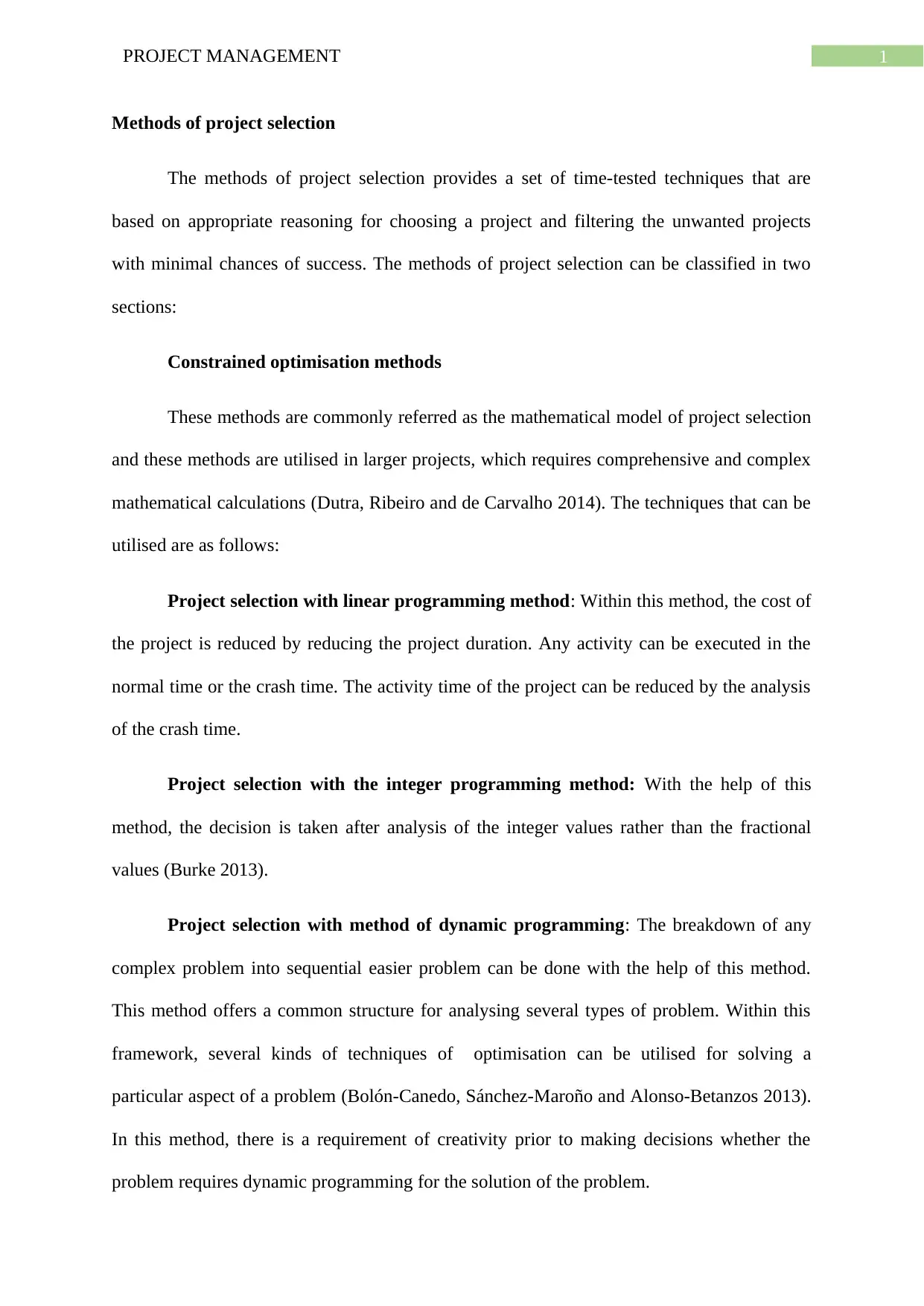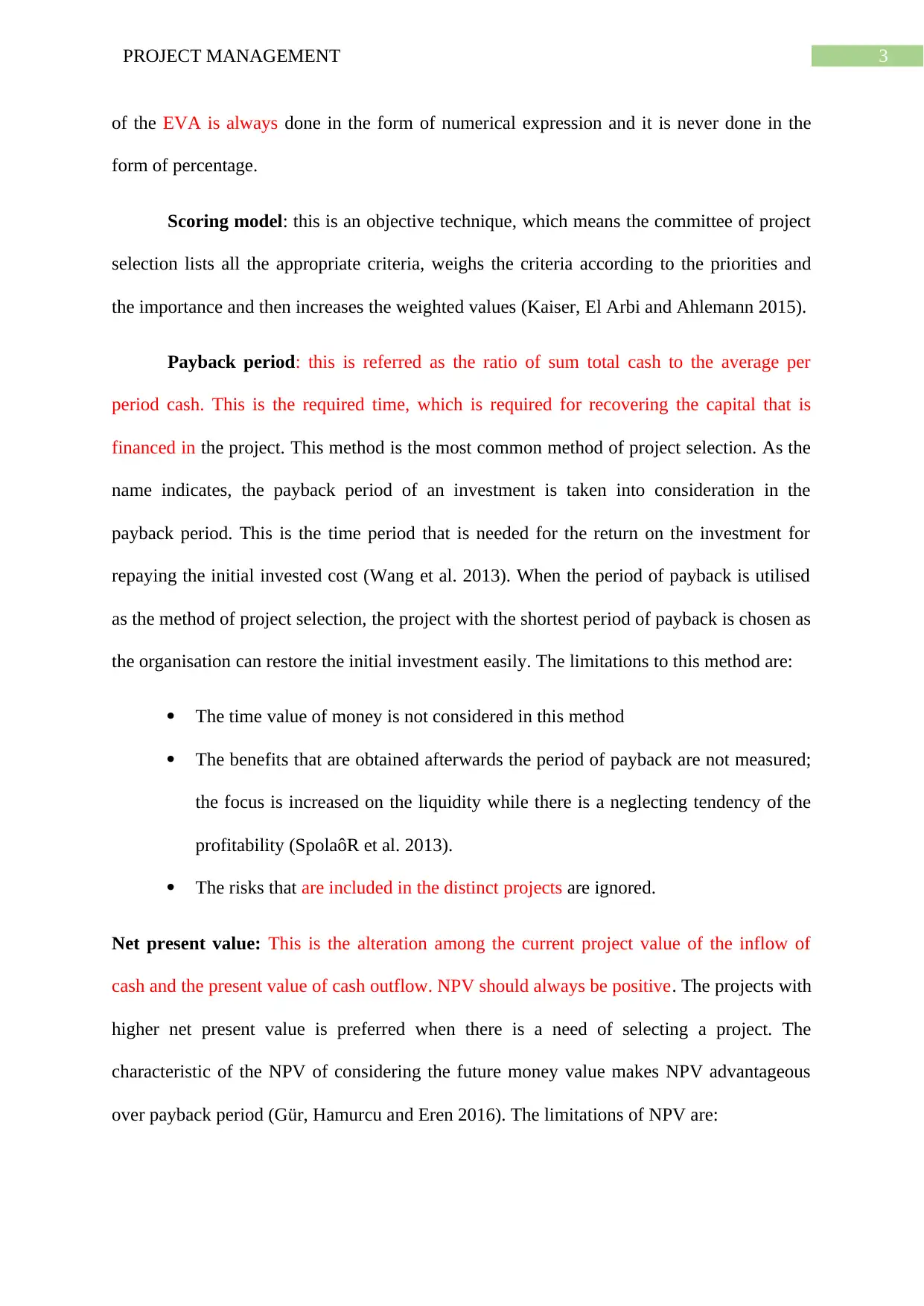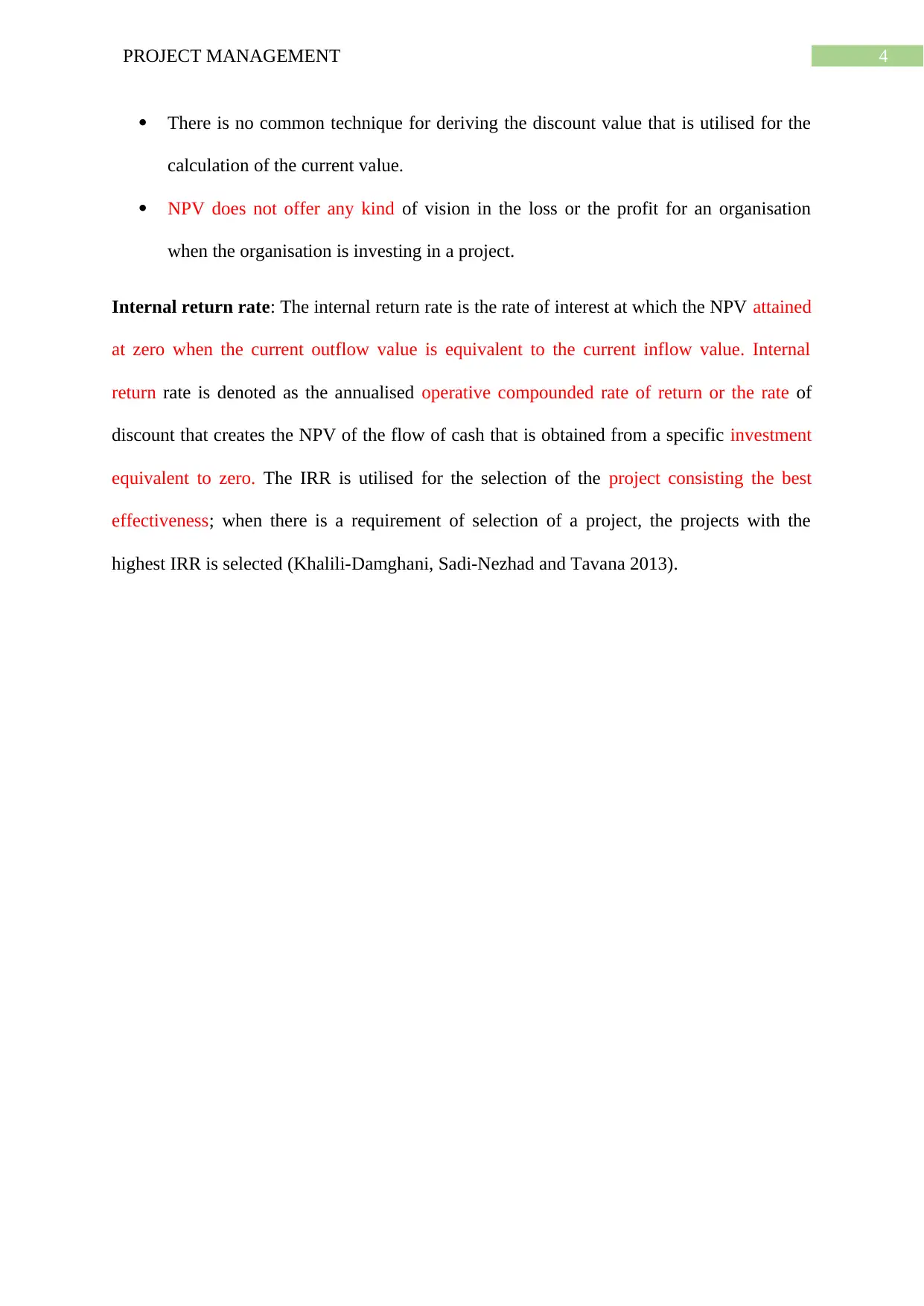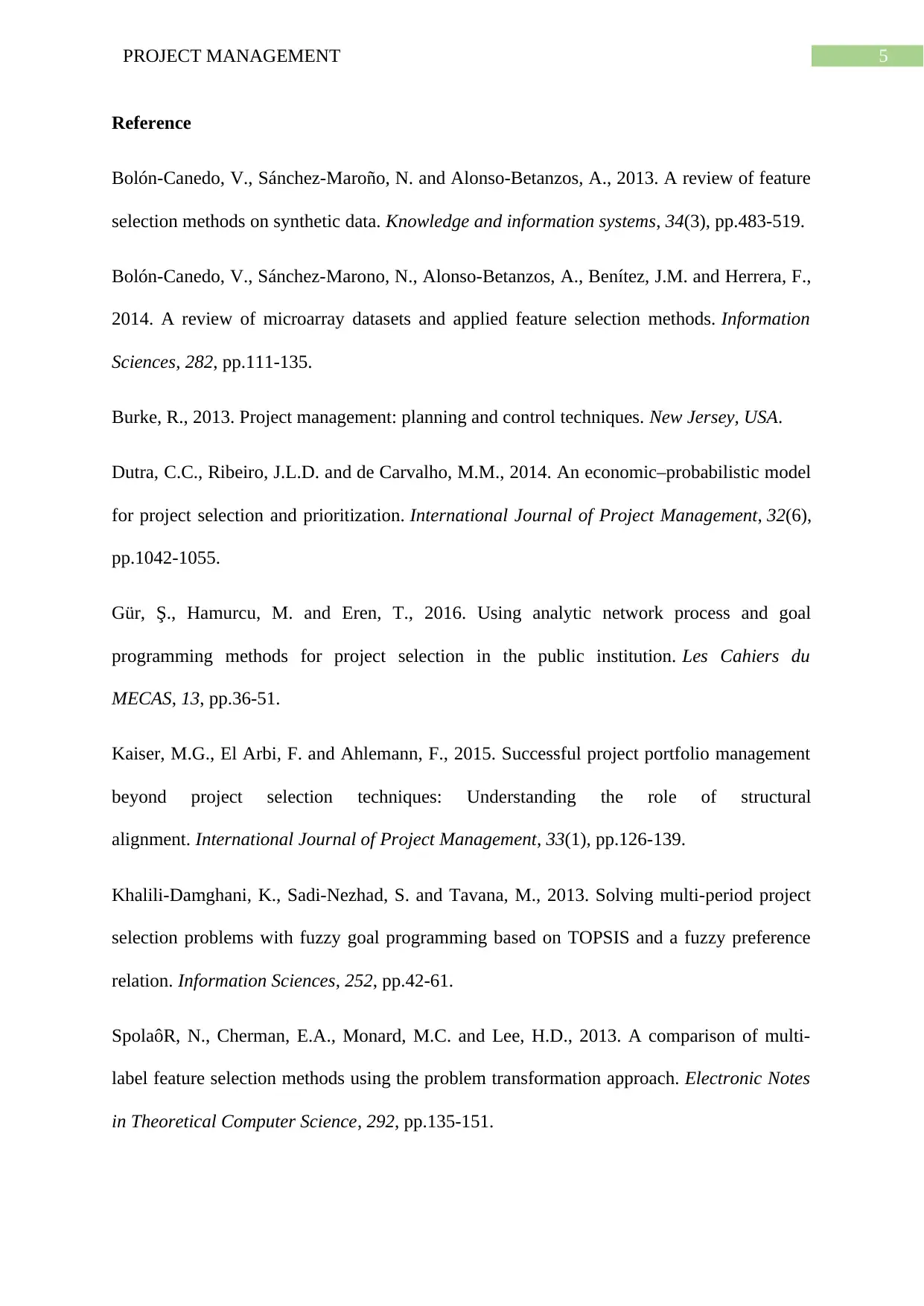PROJ6000 - Analysis of Project Selection Methods & Benefit Measurement
VerifiedAdded on 2023/06/03
|8
|1532
|499
Report
AI Summary
This report provides an overview of project selection methods, categorizing them into constrained optimization and benefit measurement techniques. Constrained optimization methods include linear programming, integer programming, dynamic programming, and multi-objective programming. Benefit measurement methods cover cost/benefit ratio, economic models like Economic Value Added (EVA), scoring models, payback period, Net Present Value (NPV), and Internal Rate of Return (IRR). The report discusses the advantages and limitations of each method, such as the payback period's failure to consider the time value of money and NPV's challenges in deriving discount values. It references various academic sources to support its analysis of these project selection techniques.

Running head: PROJECT MANAGEMENT
PROJECT MANAGEMENT
Name of student:
Name of university:
Author’s note:
PROJECT MANAGEMENT
Name of student:
Name of university:
Author’s note:
Paraphrase This Document
Need a fresh take? Get an instant paraphrase of this document with our AI Paraphraser

1PROJECT MANAGEMENT
Methods of project selection
The methods of project selection provides a set of time-tested techniques that are
based on appropriate reasoning for choosing a project and filtering the unwanted projects
with minimal chances of success. The methods of project selection can be classified in two
sections:
Constrained optimisation methods
These methods are commonly referred as the mathematical model of project selection
and these methods are utilised in larger projects, which requires comprehensive and complex
mathematical calculations (Dutra, Ribeiro and de Carvalho 2014). The techniques that can be
utilised are as follows:
Project selection with linear programming method: Within this method, the cost of
the project is reduced by reducing the project duration. Any activity can be executed in the
normal time or the crash time. The activity time of the project can be reduced by the analysis
of the crash time.
Project selection with the integer programming method: With the help of this
method, the decision is taken after analysis of the integer values rather than the fractional
values (Burke 2013).
Project selection with method of dynamic programming: The breakdown of any
complex problem into sequential easier problem can be done with the help of this method.
This method offers a common structure for analysing several types of problem. Within this
framework, several kinds of techniques of optimisation can be utilised for solving a
particular aspect of a problem (Bolón-Canedo, Sánchez-Maroño and Alonso-Betanzos 2013).
In this method, there is a requirement of creativity prior to making decisions whether the
problem requires dynamic programming for the solution of the problem.
Methods of project selection
The methods of project selection provides a set of time-tested techniques that are
based on appropriate reasoning for choosing a project and filtering the unwanted projects
with minimal chances of success. The methods of project selection can be classified in two
sections:
Constrained optimisation methods
These methods are commonly referred as the mathematical model of project selection
and these methods are utilised in larger projects, which requires comprehensive and complex
mathematical calculations (Dutra, Ribeiro and de Carvalho 2014). The techniques that can be
utilised are as follows:
Project selection with linear programming method: Within this method, the cost of
the project is reduced by reducing the project duration. Any activity can be executed in the
normal time or the crash time. The activity time of the project can be reduced by the analysis
of the crash time.
Project selection with the integer programming method: With the help of this
method, the decision is taken after analysis of the integer values rather than the fractional
values (Burke 2013).
Project selection with method of dynamic programming: The breakdown of any
complex problem into sequential easier problem can be done with the help of this method.
This method offers a common structure for analysing several types of problem. Within this
framework, several kinds of techniques of optimisation can be utilised for solving a
particular aspect of a problem (Bolón-Canedo, Sánchez-Maroño and Alonso-Betanzos 2013).
In this method, there is a requirement of creativity prior to making decisions whether the
problem requires dynamic programming for the solution of the problem.

2PROJECT MANAGEMENT
Multi objective programming method of selection: with the help of this method, the
decisions for several problems can be taken with the help of mathematical optimisation. In
the case, within any multi objective programming, not all the problems can be optimised with
a single solution, which leads to the situation of conflict and a probability of multiple optimal
solutions. Any solution will be referred as non-dominated when the optimisation of none of
the values can be done without the degradation of the values of another problem (Velasquez
and Hester 2013).
Benefit measurement methods
The method of benefit measurement is the technique of project selection that is based
on the current value of the estimated outflow of cash and the inflow. The calculation of cost
benefit is conducted and then the comparison is conducted with several other projects for
making a decision. The methods that are commonly utilised for the measurement of benefit
are:
Ratio of cost/benefit: the cost/benefit ratio is referred as the ratio among the current
inflow value or invested cost involved in project to the current value of outflow that is the
return value that is obtained from the project. The projects which provides greater ratio of
cost benefit or the lower ratio of cost benefit are commonly selected (Bolón-Canedo et al.
2014).
Economic model: Economic value added or the EVA is the metric of performance,
which calculates the worth-creation of an organisation even though it is defining the return
that is obtained on the capital. It can be also referred as the overall profit afterwards
deducting the taxes and the capital expenditure. If the project manager is handling several
projects, the project that provides the maximum economic value is selected. The expression
Multi objective programming method of selection: with the help of this method, the
decisions for several problems can be taken with the help of mathematical optimisation. In
the case, within any multi objective programming, not all the problems can be optimised with
a single solution, which leads to the situation of conflict and a probability of multiple optimal
solutions. Any solution will be referred as non-dominated when the optimisation of none of
the values can be done without the degradation of the values of another problem (Velasquez
and Hester 2013).
Benefit measurement methods
The method of benefit measurement is the technique of project selection that is based
on the current value of the estimated outflow of cash and the inflow. The calculation of cost
benefit is conducted and then the comparison is conducted with several other projects for
making a decision. The methods that are commonly utilised for the measurement of benefit
are:
Ratio of cost/benefit: the cost/benefit ratio is referred as the ratio among the current
inflow value or invested cost involved in project to the current value of outflow that is the
return value that is obtained from the project. The projects which provides greater ratio of
cost benefit or the lower ratio of cost benefit are commonly selected (Bolón-Canedo et al.
2014).
Economic model: Economic value added or the EVA is the metric of performance,
which calculates the worth-creation of an organisation even though it is defining the return
that is obtained on the capital. It can be also referred as the overall profit afterwards
deducting the taxes and the capital expenditure. If the project manager is handling several
projects, the project that provides the maximum economic value is selected. The expression
⊘ This is a preview!⊘
Do you want full access?
Subscribe today to unlock all pages.

Trusted by 1+ million students worldwide

3PROJECT MANAGEMENT
of the EVA is always done in the form of numerical expression and it is never done in the
form of percentage.
Scoring model: this is an objective technique, which means the committee of project
selection lists all the appropriate criteria, weighs the criteria according to the priorities and
the importance and then increases the weighted values (Kaiser, El Arbi and Ahlemann 2015).
Payback period: this is referred as the ratio of sum total cash to the average per
period cash. This is the required time, which is required for recovering the capital that is
financed in the project. This method is the most common method of project selection. As the
name indicates, the payback period of an investment is taken into consideration in the
payback period. This is the time period that is needed for the return on the investment for
repaying the initial invested cost (Wang et al. 2013). When the period of payback is utilised
as the method of project selection, the project with the shortest period of payback is chosen as
the organisation can restore the initial investment easily. The limitations to this method are:
The time value of money is not considered in this method
The benefits that are obtained afterwards the period of payback are not measured;
the focus is increased on the liquidity while there is a neglecting tendency of the
profitability (SpolaôR et al. 2013).
The risks that are included in the distinct projects are ignored.
Net present value: This is the alteration among the current project value of the inflow of
cash and the present value of cash outflow. NPV should always be positive. The projects with
higher net present value is preferred when there is a need of selecting a project. The
characteristic of the NPV of considering the future money value makes NPV advantageous
over payback period (Gür, Hamurcu and Eren 2016). The limitations of NPV are:
of the EVA is always done in the form of numerical expression and it is never done in the
form of percentage.
Scoring model: this is an objective technique, which means the committee of project
selection lists all the appropriate criteria, weighs the criteria according to the priorities and
the importance and then increases the weighted values (Kaiser, El Arbi and Ahlemann 2015).
Payback period: this is referred as the ratio of sum total cash to the average per
period cash. This is the required time, which is required for recovering the capital that is
financed in the project. This method is the most common method of project selection. As the
name indicates, the payback period of an investment is taken into consideration in the
payback period. This is the time period that is needed for the return on the investment for
repaying the initial invested cost (Wang et al. 2013). When the period of payback is utilised
as the method of project selection, the project with the shortest period of payback is chosen as
the organisation can restore the initial investment easily. The limitations to this method are:
The time value of money is not considered in this method
The benefits that are obtained afterwards the period of payback are not measured;
the focus is increased on the liquidity while there is a neglecting tendency of the
profitability (SpolaôR et al. 2013).
The risks that are included in the distinct projects are ignored.
Net present value: This is the alteration among the current project value of the inflow of
cash and the present value of cash outflow. NPV should always be positive. The projects with
higher net present value is preferred when there is a need of selecting a project. The
characteristic of the NPV of considering the future money value makes NPV advantageous
over payback period (Gür, Hamurcu and Eren 2016). The limitations of NPV are:
Paraphrase This Document
Need a fresh take? Get an instant paraphrase of this document with our AI Paraphraser

4PROJECT MANAGEMENT
There is no common technique for deriving the discount value that is utilised for the
calculation of the current value.
NPV does not offer any kind of vision in the loss or the profit for an organisation
when the organisation is investing in a project.
Internal return rate: The internal return rate is the rate of interest at which the NPV attained
at zero when the current outflow value is equivalent to the current inflow value. Internal
return rate is denoted as the annualised operative compounded rate of return or the rate of
discount that creates the NPV of the flow of cash that is obtained from a specific investment
equivalent to zero. The IRR is utilised for the selection of the project consisting the best
effectiveness; when there is a requirement of selection of a project, the projects with the
highest IRR is selected (Khalili-Damghani, Sadi-Nezhad and Tavana 2013).
There is no common technique for deriving the discount value that is utilised for the
calculation of the current value.
NPV does not offer any kind of vision in the loss or the profit for an organisation
when the organisation is investing in a project.
Internal return rate: The internal return rate is the rate of interest at which the NPV attained
at zero when the current outflow value is equivalent to the current inflow value. Internal
return rate is denoted as the annualised operative compounded rate of return or the rate of
discount that creates the NPV of the flow of cash that is obtained from a specific investment
equivalent to zero. The IRR is utilised for the selection of the project consisting the best
effectiveness; when there is a requirement of selection of a project, the projects with the
highest IRR is selected (Khalili-Damghani, Sadi-Nezhad and Tavana 2013).

5PROJECT MANAGEMENT
Reference
Bolón-Canedo, V., Sánchez-Maroño, N. and Alonso-Betanzos, A., 2013. A review of feature
selection methods on synthetic data. Knowledge and information systems, 34(3), pp.483-519.
Bolón-Canedo, V., Sánchez-Marono, N., Alonso-Betanzos, A., Benítez, J.M. and Herrera, F.,
2014. A review of microarray datasets and applied feature selection methods. Information
Sciences, 282, pp.111-135.
Burke, R., 2013. Project management: planning and control techniques. New Jersey, USA.
Dutra, C.C., Ribeiro, J.L.D. and de Carvalho, M.M., 2014. An economic–probabilistic model
for project selection and prioritization. International Journal of Project Management, 32(6),
pp.1042-1055.
Gür, Ş., Hamurcu, M. and Eren, T., 2016. Using analytic network process and goal
programming methods for project selection in the public institution. Les Cahiers du
MECAS, 13, pp.36-51.
Kaiser, M.G., El Arbi, F. and Ahlemann, F., 2015. Successful project portfolio management
beyond project selection techniques: Understanding the role of structural
alignment. International Journal of Project Management, 33(1), pp.126-139.
Khalili-Damghani, K., Sadi-Nezhad, S. and Tavana, M., 2013. Solving multi-period project
selection problems with fuzzy goal programming based on TOPSIS and a fuzzy preference
relation. Information Sciences, 252, pp.42-61.
SpolaôR, N., Cherman, E.A., Monard, M.C. and Lee, H.D., 2013. A comparison of multi-
label feature selection methods using the problem transformation approach. Electronic Notes
in Theoretical Computer Science, 292, pp.135-151.
Reference
Bolón-Canedo, V., Sánchez-Maroño, N. and Alonso-Betanzos, A., 2013. A review of feature
selection methods on synthetic data. Knowledge and information systems, 34(3), pp.483-519.
Bolón-Canedo, V., Sánchez-Marono, N., Alonso-Betanzos, A., Benítez, J.M. and Herrera, F.,
2014. A review of microarray datasets and applied feature selection methods. Information
Sciences, 282, pp.111-135.
Burke, R., 2013. Project management: planning and control techniques. New Jersey, USA.
Dutra, C.C., Ribeiro, J.L.D. and de Carvalho, M.M., 2014. An economic–probabilistic model
for project selection and prioritization. International Journal of Project Management, 32(6),
pp.1042-1055.
Gür, Ş., Hamurcu, M. and Eren, T., 2016. Using analytic network process and goal
programming methods for project selection in the public institution. Les Cahiers du
MECAS, 13, pp.36-51.
Kaiser, M.G., El Arbi, F. and Ahlemann, F., 2015. Successful project portfolio management
beyond project selection techniques: Understanding the role of structural
alignment. International Journal of Project Management, 33(1), pp.126-139.
Khalili-Damghani, K., Sadi-Nezhad, S. and Tavana, M., 2013. Solving multi-period project
selection problems with fuzzy goal programming based on TOPSIS and a fuzzy preference
relation. Information Sciences, 252, pp.42-61.
SpolaôR, N., Cherman, E.A., Monard, M.C. and Lee, H.D., 2013. A comparison of multi-
label feature selection methods using the problem transformation approach. Electronic Notes
in Theoretical Computer Science, 292, pp.135-151.
⊘ This is a preview!⊘
Do you want full access?
Subscribe today to unlock all pages.

Trusted by 1+ million students worldwide

6PROJECT MANAGEMENT
Velasquez, M. and Hester, P.T., 2013. An analysis of multi-criteria decision making
methods. International Journal of Operations Research, 10(2), pp.56-66.
Wang, W.M., Lee, A.H., Peng, L.P. and Wu, Z.L., 2013. An integrated decision making
model for district revitalization and regeneration project selection. Decision Support
Systems, 54(2), pp.1092-1103.
Velasquez, M. and Hester, P.T., 2013. An analysis of multi-criteria decision making
methods. International Journal of Operations Research, 10(2), pp.56-66.
Wang, W.M., Lee, A.H., Peng, L.P. and Wu, Z.L., 2013. An integrated decision making
model for district revitalization and regeneration project selection. Decision Support
Systems, 54(2), pp.1092-1103.
Paraphrase This Document
Need a fresh take? Get an instant paraphrase of this document with our AI Paraphraser

7PROJECT MANAGEMENT
1 out of 8
Related Documents
Your All-in-One AI-Powered Toolkit for Academic Success.
+13062052269
info@desklib.com
Available 24*7 on WhatsApp / Email
![[object Object]](/_next/static/media/star-bottom.7253800d.svg)
Unlock your academic potential
Copyright © 2020–2025 A2Z Services. All Rights Reserved. Developed and managed by ZUCOL.





